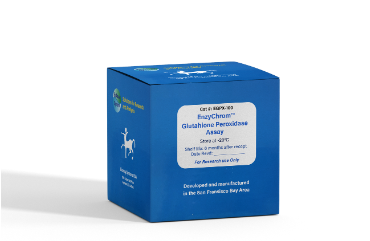DESCRIPTION
GLUTATHIONE PEROXIDASE (GPX, EC 1.11.1.9) represents an enzyme family with peroxidase activity whose main biological role is to protect the organism from oxidative damage. It helps prevent lipid peroxidation of cellular membranes by removing free peroxide in the cell. GPX catalyzes the following reaction with glutathione reductase (GR),
Simple, direct and high-throughput assays for GPX activity find wide applications. BioAssay Systems' improved assay directly measures NADPH consumption in the enzyme coupled reactions. The measured decrease in optical density at 340 nm is directly proportional to the enzyme activity in the sample.
KEY FEATURES
Sensitive and accurate. Use 10 µL sample. Linear detection range 40 to 800 U/L GPX activity.
APPLICATIONS
Direct Assays: GPX activity in biological samples.
Drug Discovery/Pharmacology: effects of drugs on GPX activity.
KIT CONTENTS (100 TESTS IN 96-WELL PLATES)
Assay Buffer: 25 mL GR Enzyme: 250 µL
Glutathione: Dried NADPH: Dried
Calibrator: Dried
Peroxide Solution: 50 µL
Storage conditions. The kit is shipped on ice. Store all components at -20°C. Shelf life of six months after receipt, 3 weeks after reconstitution.
Precautions: reagents are for research use only. Normal precautions for laboratory reagents should be exercised while using the reagents. Please refer to Material Safety Data Sheet for detailed information.
SAMPLE PREPARATION
All samples should be clear and free of any turbidity or particles. Liquid samples (e.g. non-hemolyzed serum, plasma) can be assayed directly.
Homogenize tissue (10 mg) and cells (106 ) in 200 µL cold PBS and then centrifuge 10 min at 14,000 rpm to pellet any debris. Use the clear supernatant for the assay. If not assayed immediately, freeze supernatant at -80°C (stable for 1 month).
ASSAY PROCEDURE
1. Reagent Preparation. Equilibrate all components to room temperature. Briefly centrifuge all tubes before opening. Reconstitute the NADPH tube with 400 µL dH2O (final 35 mM). Reconstitute the Glutathione tube with 540 µL dH2O (final 100 mM). Reconstitute the Calibrator with 100 µL dH2O (final 100 mM). Vortex tubes to mix. Keep these reconstituted reagent tubes on ice. Unused reagents are stable for three weeks when stored frozen at -20°C.
2. Standards and Samples. Mix 12 µL of the Calibrator with 188 µL dH2O (equivalent to 6 mM NADPH). Dilute this calibrator stock as shown in the Table below. Transfer 10 µL standards into wells of a clear flat-bottom 96-well plate. Add 190 µL Assay Buffer to all standard wells.
Transfer 10 µL of each sample into separate wells of the 96-well plate. In addition, for each assay run, include a background control that only contains 10 µL Assay Buffer. Note: For unknown samples, perform several dilutions to ensure that GPX activity is within the linear range of 40 to 800 U/L.
3. Assay. Prepare enough Working Reagent for all Sample and Control wells by mixing, for each well, 90 µL Assay Buffer, 5 µL Glutathione, 3 µL 35 mM NADPH and 2 µL GR enzyme. Add 90 µL Working Reagent quickly to the Sample/Control wells. Tap plate to mix. Transfer 5 µL Peroxide Solution into an EMPTY 1.5-mL Eppendorf tube. Add 1495 µL dH2O and mix well by vortexing for at least 30 seconds. Immediately dilute this solution 1:10 in dH2O to generate the 1x Substrate Solution. Use the diluted Solutions within one hour.
With a multi-channel pipettor, add 100 µL 1x Substrate Solution to all Sample and Control wells. Tap plate quickly to mix well contents thoroughly. Immediately read OD340nm (time zero, OD0) and again at 4 min (OD4).
CALCULATION
Use OD values at 4 min for NADPH standards. Subtract blank value (#4) from the standard values. Plot the ∆OD against standard concentrations and determine the slope of the standard curve. Calculate the ∆ODs = (OD0 – OD4) for the samples and ∆ODB = (OD0 – OD4) for the background control. Calculate the GPX activity of Sample,
The factor 1000 converts mmoles to µmoles. n is the sample dilution factor.
Note: if calculated GPX activity is higher than 800 U/L, or initial OD340nm is >1.5 in sample wells, dilute sample in dH2O and repeat assay. Multiply the results by the dilution factor.
Unit definition: one unit is the amount of GPX that produces 1 µmole of GS-SG per min at pH 7.6 and room temperature.
MATERIALS REQUIRED, BUT NOT PROVIDED
Pipetting devices, centrifuge tubes, clear flat-bottom uncoated 96-well plates, plate reader capable of reading optical density at 340 nm every minute, homogenizer (e.g. Sigma # Z359971) etc.
PUBLICATIONS
1. Medina-Leendertz, S., et al. (2018). Melatonin decreases oxidative stress in Drosophila melanogaster exposed to manganese. Investigacion Clinica, 59(3), 230-241. Assay: Glutahione peroxidase in D. melanogaster tissues.
2. Hirahara, I et al. (2020). Hypermetabolism of glutathione, glutamate and ornithine via redox imbalance in methylglyoxal-induced peritoneal injury rats. Journal of Biochemistry, 167(2), 185-194.
3. Vieira da Silva, I et al. (2021). Glutamine and cystine-enriched diets
modulate aquaporins gene expression in the small intestine of
piglets. PloS One, 16(1), e0245739.
